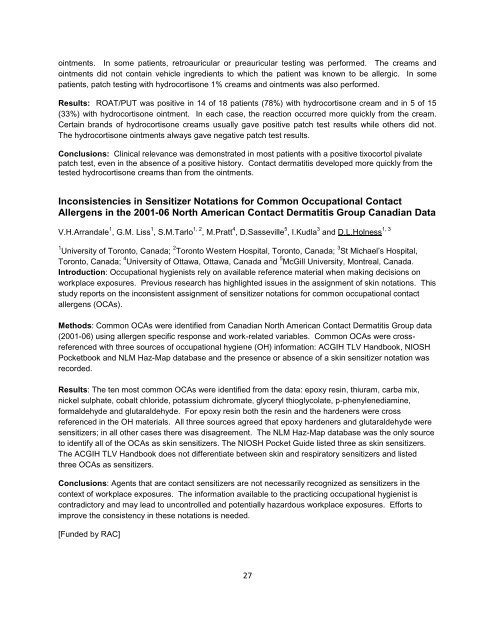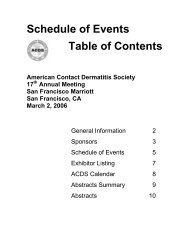American Contact Dermatitis Society 21 Annual Meeting
American Contact Dermatitis Society 21 Annual Meeting
American Contact Dermatitis Society 21 Annual Meeting
Create successful ePaper yourself
Turn your PDF publications into a flip-book with our unique Google optimized e-Paper software.
ointments. In some patients, retroauricular or preauricular testing was performed. The creams and<br />
ointments did not contain vehicle ingredients to which the patient was known to be allergic. In some<br />
patients, patch testing with hydrocortisone 1% creams and ointments was also performed.<br />
Results: ROAT/PUT was positive in 14 of 18 patients (78%) with hydrocortisone cream and in 5 of 15<br />
(33%) with hydrocortisone ointment. In each case, the reaction occurred more quickly from the cream.<br />
Certain brands of hydrocortisone creams usually gave positive patch test results while others did not.<br />
The hydrocortisone ointments always gave negative patch test results.<br />
Conclusions: Clinical relevance was demonstrated in most patients with a positive tixocortol pivalate<br />
patch test, even in the absence of a positive history. <strong>Contact</strong> dermatitis developed more quickly from the<br />
tested hydrocortisone creams than from the ointments.<br />
Inconsistencies in Sensitizer Notations for Common Occupational <strong>Contact</strong><br />
Allergens in the 2001-06 North <strong>American</strong> <strong>Contact</strong> <strong>Dermatitis</strong> Group Canadian Data<br />
V.H.Arrandale 1 , G.M. Liss 1 , S.M.Tarlo 1, 2 , M.Pratt 4 , D.Sasseville 5 , I.Kudla 3 and D.L.Holness 1, 3<br />
1 University of Toronto, Canada; 2 Toronto Western Hospital, Toronto, Canada; 3 St Michael’s Hospital,<br />
Toronto, Canada; 4 University of Ottawa, Ottawa, Canada and 5 McGill University, Montreal, Canada.<br />
Introduction: Occupational hygienists rely on available reference material when making decisions on<br />
workplace exposures. Previous research has highlighted issues in the assignment of skin notations. This<br />
study reports on the inconsistent assignment of sensitizer notations for common occupational contact<br />
allergens (OCAs).<br />
Methods: Common OCAs were identified from Canadian North <strong>American</strong> <strong>Contact</strong> <strong>Dermatitis</strong> Group data<br />
(2001-06) using allergen specific response and work-related variables. Common OCAs were crossreferenced<br />
with three sources of occupational hygiene (OH) information: ACGIH TLV Handbook, NIOSH<br />
Pocketbook and NLM Haz-Map database and the presence or absence of a skin sensitizer notation was<br />
recorded.<br />
Results: The ten most common OCAs were identified from the data: epoxy resin, thiuram, carba mix,<br />
nickel sulphate, cobalt chloride, potassium dichromate, glyceryl thioglycolate, p-phenylenediamine,<br />
formaldehyde and glutaraldehyde. For epoxy resin both the resin and the hardeners were cross<br />
referenced in the OH materials. All three sources agreed that epoxy hardeners and glutaraldehyde were<br />
sensitizers; in all other cases there was disagreement. The NLM Haz-Map database was the only source<br />
to identify all of the OCAs as skin sensitizers. The NIOSH Pocket Guide listed three as skin sensitizers.<br />
The ACGIH TLV Handbook does not differentiate between skin and respiratory sensitizers and listed<br />
three OCAs as sensitizers.<br />
Conclusions: Agents that are contact sensitizers are not necessarily recognized as sensitizers in the<br />
context of workplace exposures. The information available to the practicing occupational hygienist is<br />
contradictory and may lead to uncontrolled and potentially hazardous workplace exposures. Efforts to<br />
improve the consistency in these notations is needed.<br />
[Funded by RAC]<br />
27






